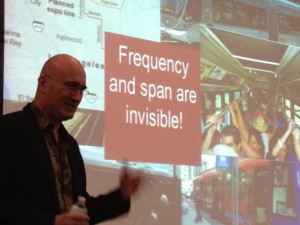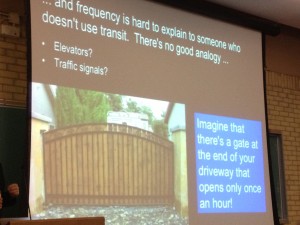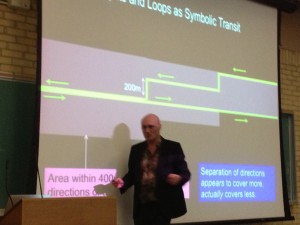Spearheaded by passionate local transit advocate/guru and prolific blogger Steve Munro, on June 19th Spacing Magazine, CodeRedTO, the ITE, and the Cities Centre welcomed Jarrett Walker, author of Human Transit: How Clearer Thinking Can Enrich Our Communities and Our Lives, for a lecture on improving our thinking on transportation.
Titled “Abundant Access: Public Transit as an Instrument of Freedom”, Walker took the crowd of over 120 through important concepts in transportation, and discussed how some of the least visible attributes of a transit service can be the most important.
Walker’s opening defined his topic for the audience:
“Abundant Access means
as many people as possible…
able to reach as many destinations as possible…
as quickly as possible..
so they have as many real choices as possible…
are therefore truly…
free.”
The principles of good network design lead to finding appropriate technology, whereas choosing a technology first can lead to implementing the wrong transit. Walker encourages us to determine our values, so decisions can flow from them. As you are likely aware, Toronto has a bad habit of getting hung up on technology choice! Regularly asked how he feels about a specific type of transit mode, Walker said that it is “very much like asking a poet for their favourite vowel.”
He also discussed the challenge that transit planners face in creating useful transit. Too often, new lines are unintentionally restricted to less useful operation, reducing their likelihood of success. The most common examples are standalone loops, which visit every required location and therefore seem like a tidy solution. “But very few of us wish to travel in circles,” Walker reminds us. Another example is separating each direction of travel onto different streets. This seems to help traffic flow or bring a larger population into the catchment area, but in fact it reduces the usefulness of a service as now fewer people are within walking distance of both directions of travel – a requirement should they wish to actually use the service!
The key messages shared by Walker were to consider how accessible and abundant transit truly creates choice, and that you can’t actually design based on predicting where people will go. Planning based on seniors like to go here, this neighbourhood goes to that temple, etc cannot succeed, because in reality “everybody is always going everywhere.”
For this reason, Walker said, he is far more excited about Toronto’s Eglinton Crosstown LRT than he is about the Finch West or Sheppard East lines. They are stub lines near the outside of the system, which he said translates into “transferring to keep going in the same direction,” whereas the Eglinton line cuts across almost the entire city and touches multiple subway lines and many major bus lines, vastly multiplying its impact. The grid approach to transit service allows much greater flexibility and ease of use, and “Toronto should be very proud of its grid,” said Walker.
Walker also made a point that will resonate in some way with nearly everyone familiar with transit issues in the GTHA: it doesn’t matter whether it’s on rails or wheels (i.e. LRT or BRT), but rather it’s the service design (the “RT” part) that has the impact. Rails that can’t move due to mixed traffic blocking its way, or buses that can’t move due to mixed traffic blocking their way, are equally poor service offerings, and don’t create real choice through revolutionizing the transit available. A poor design is inefficient, and therefore is not providing the goal: Abundant Access.
To learn more about Jarrett Walker, visit http://www.humantransit.org. His book, Human Transit, can be found at Chapters, Amazon, and Island Press


